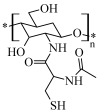Preparation and Antimicrobial Activity of Chitosan and Its Derivatives: A Concise Review
- PMID: 34204251
- PMCID: PMC8233993
- DOI: 10.3390/molecules26123694
Preparation and Antimicrobial Activity of Chitosan and Its Derivatives: A Concise Review
Abstract
Despite the advantages presented by synthetic polymers such as strength and durability, the lack of biodegradability associated with the persistence in the environment for a long time turned the attention of researchers to natural polymers. Being biodegradable, biopolymers proved to be extremely beneficial to the environment. At present, they represent an important class of materials with applications in all economic sectors, but also in medicine. They find applications as absorbers, cosmetics, controlled drug delivery, tissue engineering, etc. Chitosan is one of the natural polymers which raised a strong interest for researchers due to some exceptional properties such as biodegradability, biocompatibility, nontoxicity, non-antigenicity, low-cost and numerous pharmacological properties as antimicrobial, antitumor, antioxidant, antidiabetic, immunoenhancing. In addition to this, the free amino and hydroxyl groups make it susceptible to a series of structural modulations, obtaining some derivatives with different biomedical applications. This review approaches the physico-chemical and pharmacological properties of chitosan and its derivatives, focusing on the antimicrobial potential including mechanism of action, factors that influence the antimicrobial activity and the activity against resistant strains, topics of great interest in the context of the concern raised by the available therapeutic options for infections, especially with resistant strains.
Keywords: antimicrobial activity; chitosan; derivatives.
Conflict of interest statement
The authors declare no conflict of interest. The funders had no role in the design of the study; in the collection, analyses, or interpretation of data; in the writing of the manuscript, or in the decision to publish the results.
Figures









References
-
- Sonia T.A., Sharma C.P. Oral Delivery of Insulin. Woodhead Publishing; Cambridge, UK: 2014. 6–Polymers in Oral Insulin Delivery; pp. 257–310. - DOI
-
- Thakur S., Verma A., Sharma B., Chaudhary J., Tamulevicius S., Thakur V.K. Recent developments in recycling of polystyrene based plastics. Curr. Opin. Green Sustain. Chem. 2018;13:32–38. doi: 10.1016/j.cogsc.2018.03.011. - DOI
Publication types
MeSH terms
Substances
Grants and funding
LinkOut - more resources
Full Text Sources

